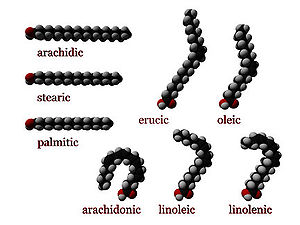
Glyceride
Encyclopedia



Ester
Esters are chemical compounds derived by reacting an oxoacid with a hydroxyl compound such as an alcohol or phenol. Esters are usually derived from an inorganic acid or organic acid in which at least one -OH group is replaced by an -O-alkyl group, and most commonly from carboxylic acids and...
s formed from glycerol
Glycerol
Glycerol is a simple polyol compound. It is a colorless, odorless, viscous liquid that is widely used in pharmaceutical formulations. Glycerol has three hydroxyl groups that are responsible for its solubility in water and its hygroscopic nature. The glycerol backbone is central to all lipids...
and fatty acid
Fatty acid
In chemistry, especially biochemistry, a fatty acid is a carboxylic acid with a long unbranched aliphatic tail , which is either saturated or unsaturated. Most naturally occurring fatty acids have a chain of an even number of carbon atoms, from 4 to 28. Fatty acids are usually derived from...
s.
Glycerol has three hydroxyl
Hydroxyl
A hydroxyl is a chemical group containing an oxygen atom covalently bonded with a hydrogen atom. In inorganic chemistry, the hydroxyl group is known as the hydroxide ion, and scientists and reference works generally use these different terms though they refer to the same chemical structure in...
functional group
Functional group
In organic chemistry, functional groups are specific groups of atoms within molecules that are responsible for the characteristic chemical reactions of those molecules. The same functional group will undergo the same or similar chemical reaction regardless of the size of the molecule it is a part of...
s, which can be esterified with one, two, or three fatty acids to form monoglyceride
Monoglyceride
A monoglyceride, more correctly known as a monoacylglycerol, is a glyceride consisting of one fatty acid chain covalently bonded to a glycerol molecule through an ester linkage....
s, diglyceride
Diglyceride
A diglyceride, or a diacylglycerol , is a glyceride consisting of two fatty acid chains covalently bonded to a glycerol molecule through ester linkages....
s, and triglyceride
Triglyceride
A triglyceride is an ester derived from glycerol and three fatty acids. There are many triglycerides, depending on the oil source, some are highly unsaturated, some less so....
s.
Vegetable oils and animal fat
Animal fat
Animal fats are rendered tissue fats that can be obtained from a variety of animals.- Pet nutrition :In pet nutrition, the source of animal fat concerns food manufacturers. AAFCO states that animal fat is "obtained from the tissues of mammals and/or poultry in the commercial processes of rendering...
s contain mostly triglycerides, but are broken down by natural enzyme
Enzyme
Enzymes are proteins that catalyze chemical reactions. In enzymatic reactions, the molecules at the beginning of the process, called substrates, are converted into different molecules, called products. Almost all chemical reactions in a biological cell need enzymes in order to occur at rates...
s (lipase
Lipase
A lipase is an enzyme that catalyzes the formation or cleavage of fats . Lipases are a subclass of the esterases.Lipases perform essential roles in the digestion, transport and processing of dietary lipids in most, if not all, living organisms...
s) into mono and diglycerides and free fatty acids.
Soap
Soap
In chemistry, soap is a salt of a fatty acid.IUPAC. "" Compendium of Chemical Terminology, 2nd ed. . Compiled by A. D. McNaught and A. Wilkinson. Blackwell Scientific Publications, Oxford . XML on-line corrected version: created by M. Nic, J. Jirat, B. Kosata; updates compiled by A. Jenkins. ISBN...
s are formed from the reaction of glycerides with sodium hydroxide. The product of the reaction is glycerol and fatty acids. Fatty acids in the soap emulsify
Emulsion
An emulsion is a mixture of two or more liquids that are normally immiscible . Emulsions are part of a more general class of two-phase systems of matter called colloids. Although the terms colloid and emulsion are sometimes used interchangeably, emulsion is used when both the dispersed and the...
the oils in dirt, enabling the removal of oily dirt with water.
Partial glycerides are esters of glycerol with fatty acids, where not all the
hydroxyl groups are esterified. Since some of its hydroxyl groups are free the molecule is polar.
Short chain partial glycerides are more
highly polarized, and have excellent solvent properties for many hard-to-solubilize drugs.

